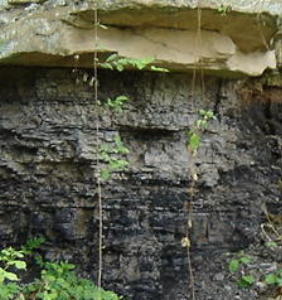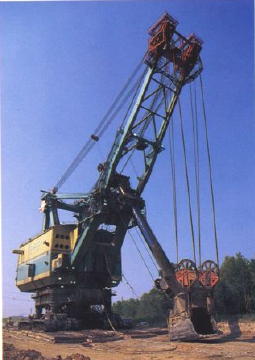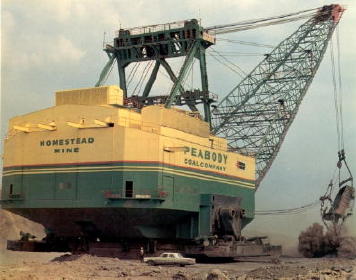  
|
Coal Mining In Kentucky.
A Large Coal Seam.
More Than You May Want To Read About.
Photo by ddd and Stat by jrd on 6/8/07
Revised code on 1/21/16.
  
|
|
COAL The coal seam above is just what it says. It is a layer of coal below the surface of the Earth. In this case, through erosion or such, this "Outcropping" has exposed the coal. An "Outcropping" of coal is an emergence of a coal seam to the surface of the earth. This particular seam of coal is about 55 inches thick and eighty feet below the surface of the earth. A coal seam much thicker than 60 inches is uncommon in the state of Kentucky. Coal seams in the forty inch range is more prevalent. In many cases, a seam of coal may have other seams above or below and separated by dirt and/or rock. A coal seam is identified by a number rather than a name. A number nine coal seam is a particular type of coal, while a number thirteen coal seam is another. The #9 seam is generally better coal, but it is usually deeper in the earth. A #9 coal seam may have a layer of #11 coal above it and a #13 seam above the #11. Any of these coal seems may be from just a few feet under the surface of the earth to a few hundred feet. Eons ago, people discovered this type of outcropping of coal. They soon learned that the coal would burn, and produce heat if ignited, and coal mining was discovered. Pretty neat. Just go up to the surface of the outcropping and pick out the coal. It was not long before the "Miner" had to go deeper, as the surface part of the coal was being consumed. If it can happen, it will. Eventually, a "Top" fell on a miner and the dangers of being beneath the earth was evident. This problem was corrected or mostly correctly by some form of roof support. As coal mining evolved, timbers were used to form a support for the roof and eventually, it was discovered that a large bolt could be screwed into the rock above the coal seam to support the roof. This "Roof Bolt" was screwed into the stronger layer of rock above the coal seam. Initially, the early coal miners would dig out the coal with whatever they could find and probably with some form of a rock and wooden pry bar. After iron was discovered, picks, shovels and pry bars were made and used by the miner. The miner could now go into the mine and bring out the coal. It was a crude method, but new ideas formed and "Underground Mining" was slowly evolving into mechanized mining. Now, huge mechanical "Miners" dig out the coal and load it on conveyor belts that bring the coal back to the surface. Other large machines are used in the mining of the coal. "Roof Bolters" are huge drills that screw long bolts to the ceiling of the mine. "Man Cars" or rail cars are used to take the miner deep into the mine. Being underground, and with large mechanical equipment, large ventilation fans and electricity are the norm for the miner, but this type of environment makes for a dangerous place to work. This is "Underground Mining". Another method of removing the coal from the earth probably occurred soon after the discovery of coal. Just remove the earth and rock or "Overburden" from the top of the coal and dig the coal without going underground. Again, it sounds simple and may have been at first when some coal seams were covered with just a few inches of overburden. Fast forward time a few hundred years to the later years of the nineteenth century. Mechanical equipment was now being used to remove the overburden and to dig out the coal. The coal was loaded into large trucks and "Trucked" from the mine pit to the processing area. From this processing area, Kentucky Coal would be shipped by truck, rail, or river to areas where it was consumed. Power plants and steel mills were purchasing large quantities of coal to be used in their process. From about the start of the twentieth century two types of "Strippers" were being build and used. A "Shovel" and a "Dragline" were the names used to describe this type of equipment to remove the "Overburden" from the top of the coal seam. These machines were relative small at first and were powered by steam and thus, called "Steam Shovels". Fuel was readily available as well as water and these "Steam Shovels" were extensively used until about the early forties. By now, electricity was being used to power the "Shovels" and the "Draglines". It seemed that each mine was in competition with each other to see which one could purchase and use the largest pieces of equipment. The decision was to purchase the largest "Shovel" or the largest "Dragline" that could be made. A "Shovel" has some advantages and a "Dragline" had some advantages. In the early years, the draglines were mostly used for "ditching" and dam construction while the shovel was used to remove the overburden.  A Peabody Coal Company Shovel. A large "Stripping Shovel" is a site to behold and especially when it is in the pit digging the overburden. These very large "Strippers" are so heavy that they have to be positioned on a hard surface or they will sink in the ground. As long as they are on top of a coal seam, they can scoop up the earth from the top of the coal and deposit in on the waste side. Large mats are used if the shovel has to be moved from the coal seam, as for instance when they are moving from one pit to another pit. The shovel will strip along the coal seam and this may be for miles. A "Loader" will follow the stripper in the pit. When the stripper reaches the end of a coal seam, it will turn around and head in the direction that it came until it reaches the other end of the coal seam. This process continues until this "Pit" is void of coal. As the "Loader" digs the coal from the pit and loads it in large trucks, room is being made for the "Stripper" to have a place to deposit the dirt and rocks that it is being dug. A limiting factor in the depth of the "Overburden" that can be removed is room for the "Overburden" to be deposited. If the "Shovel" does not have a place to dump the dirt and rocks, then it can no longer dig. An "Overburden" depth more than a hundred feet or so begins to present a problem to the mine. In the last forty or so years, "Dozers" have been operated on top of the "Spoils" to better place the "Overburden". This creates more space for the "Stripper" to dig. Large draglines have even been used to reposition this overburden. The "Dragline". Ah, this is a site to behold and especially some of the new and larger draglines.  A Peabody Coal Company Dragline. The first of the Marion 8800 series of draglines and the first to break the 100 cu-yd barrier. Peabody Coal Company started using this one at their Homestead Mine in Western Kentucky in 1961. As you can determine, these machines are enormous. While the "Shovel" rests on tracks and on the coal seam, a dragline will rest on a large pan and on top of the "Overburden" or in some cases, the "Spoil". The "Spoil" is the earth and rocks that has been removed from the top of the coal and placed on the area of the pit where the coal has been removed. Crawlers are positioned on each corner of the dragline and to move the dragline forward, the "Crawlers" move out and then down so as to take the weight off the pan and sort of drag the pan a few feet forward. If a person stood to the side of the dragline the crawler would appear to move in a circular orbit such as to move up, then toward the front of the dragline, down, and then to the rear of the machine. In doing so, the dragline is inched forward for each circular motion of the crawlers. A level and a firm base must be available for the dragline to rest and to move. This base is being prepared as the dragline operates. While it is digging the overburden, a dragline operator is constantly trying to help keep a base prepared so the dragline can have a firm place to move while in the process of stripping. Dozers, or other earth pushing equipment work with a dragline to help build this base or foundation for the dragline. While the bucket of a "Shovel" is working away from the "Stripper", a dragline bucket is "Dragged" toward the operator. In its' simplest form, the dragline operator will position the boom of the dragline over where he wants to strip, lowers the "Bucket" and drags it toward him until the bucket is full. Now, he will hoist the bucket swing it to the spoil side and dump the overburden. Over and over, this process is repeated until he runs out of a place to reach. Now, the dragline is moved backward and the process starts over. Simple sounding, but with large machines, large equipment, electricity, moving parts, inclement weather, etc., this process is a very dangerous place to work in and all of the miners must be careful in order to be able to return the next day. If you have reached this point, I would like to thank you for reading the material. The information that was written was some material that has been etched in this old brain. I think that all is true and factual. If you find something that is incorrect, feel free to let me know. Thanks again. See you..... jrd |
Click on following logo to contact me.
